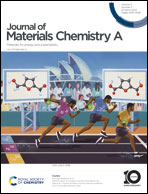A hydrophilic fully conjugated covalent organic framework for photocatalytic CO2 reduction to CO nearly 100% using pure water†
Abstract
Designing stable eco-friendly materials that use abundant H2O as the hydrogen and electron source for photocatalytic conversion of CO2 presents a promising route to confronting climate change, but it remains challenging. In this work, we demonstrated that the strategy of converting imine-linkers into 4-carboxyl-quinoline linkages in covalent organic frameworks (COFs) could be used to prepare efficient crystalline porous polymeric photocatalysts for CO2 reduction using H2O as the electron donor. In particular, QL-COF, featuring hydrophilic 4-carboxyl-quinoline linkages, was found to show improved adsorption of H2O and CO2 compared with LZU1-COF which was constructed via imine linkages. Theoretical studies indicated that hydrophilic –COOH groups presented strong binding with H2O molecules. Importantly, the pre-adsorbed H2O molecules were found to further enhance the binding of CO2 molecules in the pores. The fully conjugated framework of QL-COF improved the separation and transfer of photogenerated charge carriers, leading to excellent activity and photostability for photoreduction of CO2 with gaseous H2O. Ultimately, QL-COF reached a high selectivity of 99.3% for CO generation (156 μmol g−1 h−1) under simulated sunlight irradiation.

- This article is part of the themed collections: Journal of Materials Chemistry A HOT Papers and #MyFirstJMCA


 Please wait while we load your content...
Please wait while we load your content...